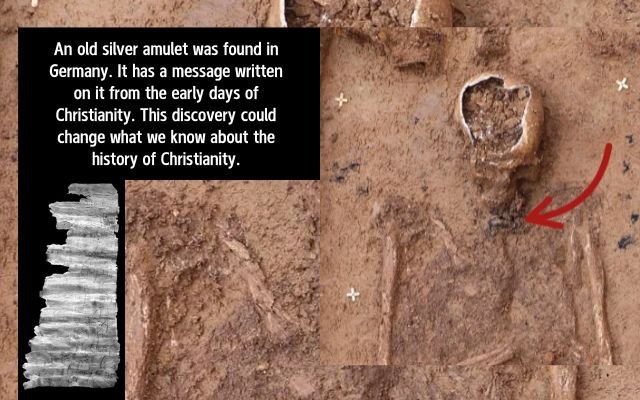Ancient Silver Amulet Found: Rewriting Early Christian History
Ancient silver amulet discovered in Germany reveals earliest evidence of Christianity north of the Alps, reshaping early Christian history.

Archaeologists have made exciting discovery in 3rd-century Roman grave near Frankfurt, Germany. They found an important artifact, a silver amulet, which is the earliest evidence of Christianity ever found in the region north of the Alps. This amulet called “Frankfurt Silver Inscription,” is believed to be from around 230-270 CE, making it much older than other Christian artifacts previously discovered in this area, by nearly 50 years.
Amulet is a small, rolled-up piece of silver foil that was buried with a man who was about 35-45 years old. This man was laid to rest with other items such as pottery and incense burner, common in Roman burials. Silver amulet is especially significant because it contains a religious text, a message that shows the presence of Christian beliefs long before other known Christian objects in this part of Roman Empire.
This find is important because it helps us learn more about the spread of Christianity during a time when the religion was still new and not widely accepted across the Roman Empire. The amulet is the earliest proof of Christianity in this part of Europe, which was an important and busy region during the Roman era. This discovery also helps us understand how early Christians lived and practiced their faith in places far from the main Christian centers of the time.
This silver amulet shows that Christianity was spreading in northern parts of the Roman Empire in the third century, earlier than we thought. It also shows how discoveries like this can change what we know about history and religion in the past.
Key Discovery and Importance of Ancient Silver Amulet Found
A silver amulet was found in a 2017-2018 excavation at a Roman cemetery in the Heilmannstraße area, once part of the ancient city of Nida. The site had 127 graves and stood out for its many inhumation burials, a practice rare in other Roman cemeteries in Frankfurt. Among these graves, one was particularly unique—it belonged to a man aged 35-45 years. Along with grave items like an incense burner and pottery, archaeologists found a small rolled piece of silver foil under his chin. This amulet, likely worn on a ribbon around the neck, is called a phylactery, a type of container believed to protect the wearer through its contents.
The researchers examined the lettering on the silver foil using current technologies. They utilized a scanner to digitally “unroll” the delicate scroll without touching it, which could easily shatter. This showed an 18-line Latin manuscript with purely Christian content, which was quite rare at the period.
Meaning of the Inscription
The Frankfurt Silver Inscription is written in Latin and has been translated into English. It mentions St. Titus, a follower of Apostle Paul, and includes Christian phrases like “Holy, holy, holy!” and “In the name of Jesus Christ, Son of God.” It also quotes the Bible, from Paul’s letter to the Philippians, saying every knee should bow and every tongue confess the name of Jesus Christ.
Inscription appears to be a prayer or a protective message, asking for well-being and spiritual protection for the person who wore the amulet. It speaks about surrendering to the will of Jesus Christ and refers to Him as the Lord of the world.
Prof. Dr. Markus Scholz from Goethe University, Frankfurt, said the text is detailed and carefully written, likely by an expert scribe. What makes it special is that it has only Christian content. This is unusual because amulets from that time often mixed Christian, Jewish, and pagan symbols. The purely Christian text shows the wearer’s strong faith and makes this artifact rare and important.
Amulets from this time usually mixed Christian, Jewish, and pagan symbols. However, this one has no mention of Yahweh, angels, or pagan gods, making it fully Christian. This shows the wearer’s strong devotion and raises questions about the presence of Christianity in Nida, a city that was an important center in Roman Germania.
Why This Matters
Discovery is important for archaeology, theology, and Roman history. It changes the timeline of when Christianity appeared in the region, showing it was present much earlier than we thought. While historical records suggested Christian communities in nearby areas by the late 2nd century, actual evidence north of the Alps was not found until the 4th century.
Role of Technology and Collaboration
The careful study and preservation of the amulet show the benefits of teamwork between different organizations. Many partners worked together on the project, including the City of Frankfurt, the Archaeological Museum Frankfurt, LEIZA, Goethe University Frankfurt, the University of Bonn, and others.
Dr. Ivan Calandra of LEIZA explained the difficulties of working with the amulet, pointing out that the silver sheet had been crumpled and compacted after 1,800 years. They used a CT scanner to scan the amulet in detail and build a 3D replica.
- Did Venus Ever Have Oceans?
- ISS Leak Threatens Astronauts, NASA Warns of Catastrophe
- Researchers Uncover Massive Ancient ‘Terror Bird’ Fossil in South America
A Glimpse into Early Christianity
This discovery is the first evidence of Christianity in the northern Roman Empire, showing how connected the empire was. Nida, where the amulet was found, was a busy city with many cultural and religious influences. It opens the door for more research into how Christianity grew and spread in this active area during the third century.



